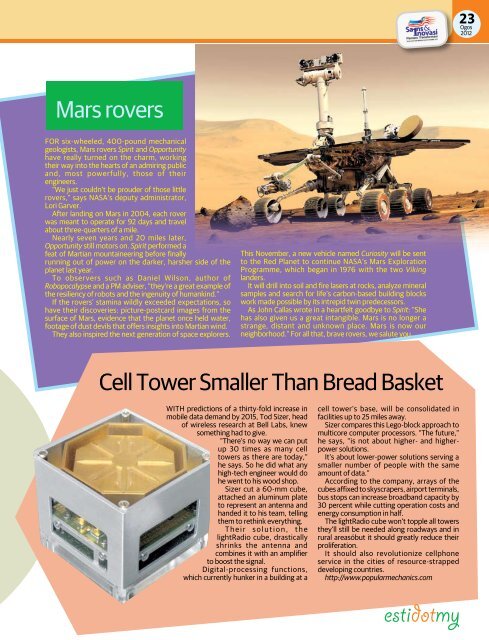Teknologi Mega Sains - Portal Rasmi Akademi Sains Malaysia
Teknologi Mega Sains - Portal Rasmi Akademi Sains Malaysia
Teknologi Mega Sains - Portal Rasmi Akademi Sains Malaysia
- No tags were found...
Create successful ePaper yourself
Turn your PDF publications into a flip-book with our unique Google optimized e-Paper software.
23Ogos2012Mars roversfor six-wheeled, 400-pound mechanicalgeologists, Mars rovers Spirit and Opportunityhave really turned on the charm, workingtheir way into the hearts of an admiring publicand, most powerfully, those of theirengineers.“We just couldn’t be prouder of those littlerovers,” says NASA’s deputy administrator,Lori Garver.After landing on Mars in 2004, each roverwas meant to operate for 92 days and travelabout three-quarters of a mile.Nearly seven years and 20 miles later,Opportunity still motors on. Spirit performed afeat of Martian mountaineering before finallyrunning out of power on the darker, harsher side of theplanet last year.To observers such as Daniel Wilson, author ofRobopocalypse and a PM adviser, “they’re a great example ofthe resiliency of robots and the ingenuity of humankind.”If the rovers’ stamina wildly exceeded expectations, sohave their discoveries: picture-postcard images from thesurface of Mars, evidence that the planet once held water,footage of dust devils that offers insights into Martian wind.They also inspired the next generation of space explorers.This November, a new vehicle named Curiosity will be sentto the Red Planet to continue NASA’s Mars ExplorationProgramme, which began in 1976 with the two Vikinglanders.It will drill into soil and fire lasers at rocks, analyze mineralsamples and search for life’s carbon-based building blockswork made possible by its intrepid twin predecessors.As John Callas wrote in a heartfelt goodbye to Spirit: “Shehas also given us a great intangible. Mars is no longer astrange, distant and unknown place. Mars is now ourneighborhood.” For all that, brave rovers, we salute you.Cell Tower Smaller Than Bread BasketWITH predictions of a thirty-fold increase inmobile data demand by 2015, Tod Sizer, headof wireless research at Bell Labs, knewsomething had to give.“There’s no way we can putup 30 times as many celltowers as there are today,”he says. So he did what anyhigh-tech engineer would dohe went to his wood shop.Sizer cut a 60-mm cube,attached an aluminum plateto represent an antenna andhanded it to his team, tellingthem to rethink everything.Their solution, thelightRadio cube, drasticallyshrinks the antenna andcombines it with an amplifierto boost the signal.Digital-processing functions,which currently hunker in a building at acell tower’s base, will be consolidated infacilities up to 25 miles away.Sizer compares this Lego-block approach tomulticore computer processors. “The future,”he says, “is not about higher- and higherpowersolutions.It’s about lower-power solutions serving asmaller number of people with the sameamount of data.”According to the company, arrays of thecubes affixed to skyscrapers, airport terminals,bus stops can increase broadband capacity by30 percent while cutting operation costs andenergy consumption in half.The lightRadio cube won’t topple all towersthey’ll still be needed along roadways and inrural areasóbut it should greatly reduce theirproliferation.It should also revolutionize cellphoneservice in the cities of resource-strappeddeveloping countries.http://www.popularmechanics.com

















